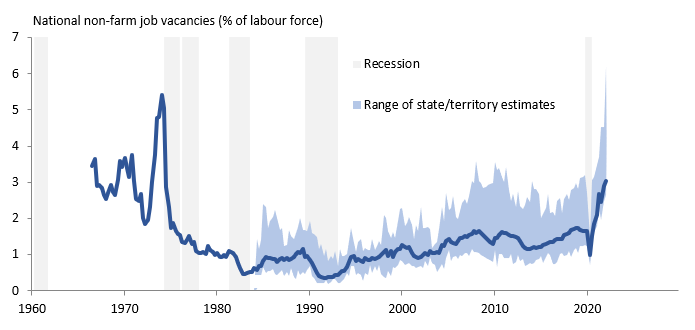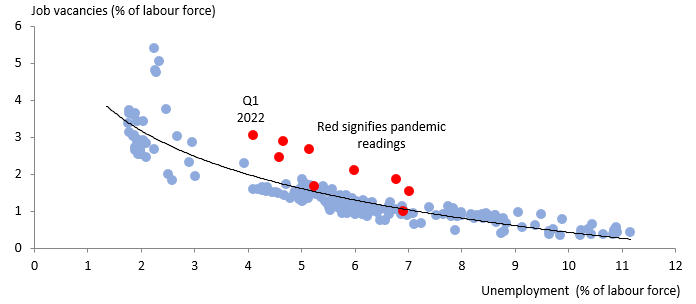Sky-high vacancies suggest the jobless rate will decline further to 3-point-something per cent ...
Recent data on both job vacancies and worker mobility show that Australia's labour market is continuing to tighten, pointing to ongoing reductions in the unemployment rate and higher wages growth. In fact, current vacancy rates are consistent with a much lower unemployment rate, raising the prospect of a very rare 3-handle being recorded soon. This will only increase pressure on the Reserve Bank of Australia to soon start raising the cash rate, unwinding the emergency rate cuts of 2020.
Soaring job vacancies
Job vacancies continue to surge, up 7% in the first quarter of 2022. Vacancies are now 3% of the labour force, which is the highest share since just before the economy entered recession in late 1974. Vacancies are extremely high as a share of the labour force in every state and territory, but among the states WA has almost reached 4½%.
Some vacancies will be filled when non-resident workers return to Australia, but based on the pre-pandemic relationship between vacancies and the unemployment rate, Coolabah Capital Investments estimates that the current level of vacancies is consistent with an unemployment rate of around 2% (see the first two charts below).
Assuming that the unemployment rate soon falls into the 3s for the first time since 1974, this will place pressure on wages growth given the Reserve Bank thinks the NAIRU ranges between the high 3s and low 4s, while the bank's inflation model suggests the NAIRU is higher at 5¼%.


Labour mobility points to greater wage pressures
With the unemployment rate likely to fall further, recent data also show clear signs of increased job mobility in Australia - albeit still nothing like the great resignation phenomenon in the US - which is also consistent with a pick-up in wages growth.
About 5½% of workers have recently started a new job, which is the highest share in about a decade, mostly reflecting part-time workers changing jobs. More notable is the increase in the share of workers who plan to either change jobs or seek other employment over the next twelve months, which at about 5¼% is at the highest point since the global financial crisis.
This has been driven by full-time workers, where about 4¾% of full-time staff plan to quit over the next twelve months, which is the highest share since data first became available in 2001.
Importantly for the RBA, increased job switching places upward pressure on labour costs and hence inflation, but not the wage price index, which is a pure measure of wages growth that is not affected by changes in the occupational/industry mix of the workforce.
The Reserve Bank has recently emphasised that it evaluates a broad range of labour cost benchmarks when assessing inflation pressures, including both the unit labour costs series reported in the national accounts as well as the wage price index. The former is more likely to signal sooner that the economy is generating wages growth that is consistent with sustainable core inflation within the Reserve Bank's 2-3% target band, which the bank has set as a pre-condition for its first hikes.
We continue to expect 2-3 rate hikes from the Reserve Bank this year, which will eventually apply downward pressure on national house prices.

US unemployment rate is now well below the US NAIRU
In the US, the unemployment rate is practically back at pre-pandemic levels and well below estimates of the NAIRU. That is, the unemployment rate fell to 3.6% in March, almost matching the pre-pandemic low of 3.5% that itself was the lowest unemployment rate since 1969 and one of the lowest rates in modern history.
This indicates that there is excess demand in the US labour market as the unemployment rate is now well below the FOMC's median estimate of the NAIRU of 4% and outside the range of individual FOMC-member estimates of 3.8-4.2% (it is also below the median market estimate of the NAIRU of 3.8% in Q3 last year).
Wages growth has reacted to the tighter labour market, where there has also been a supply response to the pandemic itself, with the strongest growth in wages in people-facing industries, such as hospitality, retail, health and education, presumably reflecting concern about catching COVID.
The tightness of the labour market combined with the risk that high actual inflation will feed into high inflation expectations helps explain the Fed's pressing need to quickly return monetary policy to a more neutral setting and potentially adopt tight policy.
Never miss an update
Enjoy this wire? Hit the 'like' button to let us know. Stay up to date with my content by hitting the 'follow' button below and you'll be notified every time I post a wire.
Not already a Livewire member? Sign up today to get free access to investment ideas and strategies from Australia’s leading investors.
3 topics

